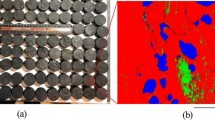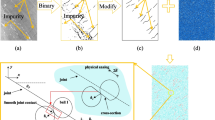Abstract
During hydraulic fracturing, the coal matrix is continually exposed to injected fluids, and the resulting chemical interactions significantly impact the coal seam′s mechanical response. However, there is still a lack of quantitative evaluation and mechanistic understanding of such exposures and the associated interactions. Here we investigate the dynamic mechanical response of coal samples after exposure to different concentrations of KCl brine. To this end, the dynamic compressive strength and elastic modulus of coal are measured as a function of KCl brine concentrations (1–3 wt%), exposure times (24 h and 72 h), and impact velocity (4.502–9.504 m/s) using split Hopkinson pressure bar (SHPB) tests. Fractal analysis of the experimental observations is also performed. The results indicate that coal's dynamic mechanical properties, including dynamic compressive strength, stress–strain relationship, and typical failure mode, are closely related to the impact loading rate. Importantly, we find that the dynamic elastic modulus of the coal decreases with prolonged exposure to a higher concentration of KCl brine. Also, with the action of low salinity fracturing fluid, the fractal dimension D of the coal sample shows a downward trend. These findings will help understand the change of dynamic mechanical properties in deep coal seams during fracturing fluid injection, which is significant in preventing pre-mature fracture closure, borehole collapse, and gas outbursts.
Article highlights
-
1.
Mechanistic testing and quantitative evaluation of dynamic responses of coal exposures to KCL brine.
-
2.
Dynamic compressive strength and elastic modulus of coal are measured as a function of KCl brine concentrations, exposure times and impact velocity.
-
3.
Fractal dimension factor method was introduced to analyze crushing characteristics of coal under different loading conditions.














Similar content being viewed by others
References
Ai T, Wu S, Zhang R et al (2021) Changes in the structure and mechanical properties of a typical coal induced by water immersion. Int J Rock Mech Min 138:104597
Arif M, Mahmoud M, Zhang Y, Iglauer S (2021) X-ray tomography imaging of shale microstructures: a review in the context of multiscale correlative imaging. Int J Coal Geol 233:103641
Bagde MN, Raina AK, Chakraborty AK, Jethwa JL (2002) Rock mass characterization by fractal dimension. Eng Geol 63(1):141–155
Bai J, Kang Y, Chen Z, You L, Chen M, Li X (2020) Changes in Retained Fracturing Fluid Properties and their Effect On Shale Mechanical Properties. J Nat Gas Sci Eng 75:103163
Bao X, Guo J, Liu Y et al (2021) Damage characteristics and laws of micro-crack of underwater electric pulse fracturing coal-rock mass. Theor Appl Fract Mec 111:102853
Chengyang W, Shixiong H, Wen**g S, Wei C (2012) Fractal dimension of coal particles and their CH4 adsorption. Int J Min Sci Technol 22(6):855–858
Dayioglu M, Cetin B, Nam S (2017) Stabilization of expansive Belle Fourche shale clay with different chemical additives. Appl Clay Sci 146:56–69
Dutler N, Valley B, Gischig V et al (2020) Hydromechanical insight of fracture opening and closure during in-situ hydraulic fracturing in crystalline rock. Int J Rock Mech Min 135:104450
Fan C, Li S, Luo M, Du W, Yang Z (2017) Coal and gas outburst dynamic system. Int J Min Sci Technol 27(1):49–55
Ferrer I, Thurman EM (2015) Chemical constituents and analytical approaches for hydraulic fracturing waters. Trends Environ Anal Chem 5:18–25
Finkelman RB, Dai S, French D (2019) The importance of minerals in coal as the hosts of chemical elements: a review. Int J Coal Geol 212:103251
Gu H, Tao M, Li X, Li Q, Cao W, Wang F (2018) Dynamic response and failure mechanism of fractured coal under different soaking times. Theor Appl Fract Mec 98:112–122
Gu H, Tao M, Cao W, Zhou J, Li X (2019) Dynamic fracture behaviour and evolution mechanism of soft coal with different porosities and water contents. Theor Appl Fract Mec 103:102265
Hu Q, Liu L, Li Q et al (2020) Experimental investigation on crack competitive extension during hydraulic fracturing in coal measures strata. Fuel 265:117003
Huang F, Kang Y, You L, Li X, You Z (2018) Massive fines detachment induced by moving gas-water interfaces during early stage two-phase flow in coalbed methane reservoirs. Fuel 222:193–206
Huang T, Cao L, Cai J, Xu P (2019) Experimental investigation on rock structure and chemical properties of hard brittle shale under different drilling fluids. J Petrol Sci Eng 181:106185
**gna X, Jun X, Guanhua N, Rahman S, Qian S, Hui W (2020) Effects of pulse wave on the variation of coal pore structure in pulsating hydraulic fracturing process of coal seam. Fuel 264:116906
Kong X, Li S, Wang E et al (2021) Dynamics behaviour of gas-bearing coal subjected to SHPB tests. Compos Struct 256:113088
Kumar D, Ghassemi A (2018) Three-dimensional poroelastic modeling of multiple hydraulic fracture propagation from horizontal wells. Int J Rock Mech Min 105:192–209
Li D, Wang E, Kong X, Ali M, Wang D (2019) Mechanical behaviors and acoustic emission fractal characteristics of coal specimens with a pre-existing flaw of various inclinations under uniaxial compression. Int J Rock Mech Min 116:38–51
Li S, Ni G, Wang H, Xun M, Xu Y (2020) Effects of acid solution of different components on the pore structure and mechanical properties of coal. Adv Powder Technol 31(4):1736–1747
Liang X, Liang T, Zhou F et al (2021) Impact of shut-in time on production after hydraulic fracturing in fractured shale gas formation: an experimental study. J Nat Gas Sci Eng 88:103773
Lin S, Lai B (2013) Experimental investigation of water saturation effects on barnett shale’s geomechanical behaviors. OnePetro 65:108–124
Lu J, Yin G, Zhang D, Gao H, Li C, Li M (2020) True triaxial strength and failure characteristics of cubic coal and sandstone under different loading paths. Int J Rock Mech Min 135:104439
Luo S, Wu Y, Li Y et al (2021) Nanoindentation-enhanced screening of hydraulic fracturing fluid additives. Int J Coal Geol 240:103744
Mou P, Pan J, Wang K, Wei J, Yang Y, Wang X (2021) Influences of hydraulic fracturing on microfractures of high-rank coal under different in-situ stress conditions. Fuel 287:119566
Parchei-Esfahani M, Gee B, Gracie R (2020) Dynamic hydraulic stimulation and fracturing from a wellbore using pressure pulsing. Eng Fract Mech 235:107152
Park J, Iino A, Datta-Gupta A, Bi J, Sankaran S (2021) Novel hybrid fast marching method-based simulation workflow for rapid history matching and completion design optimization of hydraulically fractured shale wells. J Petrol Sci Eng 196:107718
Perfect E (1997) Fractal models for the fragmentation of rocks and soils: a review. Eng Geol 48(3):185–198
Sampath KHSM, Perera MSA, Ranjith PG, Matthai SK, Dong-Yin L (2019) Qualitative and quantitative evaluation of the alteration of micro-fracture characteristics of supercritical co2-interacted coal. J Super Fluids 147:90–101
Sobhaniaragh B, Trevelyan J, Mansur WJ, Peters FC (2017) Numerical simulation of MZF design with non-planar hydraulic fracturing from multi-lateral horizontal wells. J Nat Gas Sci Eng 46:93–107
Sun Z, Zhang H, Wei Z et al (2018) Effects of slick water fracturing fluid on pore structure and adsorption characteristics of shale reservoir rocks. J Nat Gas Sci Eng 51:27–36
Turcotte DL (1986) Fractals and fragmentation. J Geophys Res 91:1921
Ulusay R (ed) (2015) The ISRM suggested methods for rock characterization, testing and monitoring: 2007-2014. Springer, Cham
Wang C, Cheng Y, He X, Yi M, Wang Z (2019) Size effect on uniaxial compressive strength of single coal particle under different failure conditions. Powder Technol 345:169–181
Wang C, Cheng Y, Yi M, Hu B, Jiang Z (2020) Surface energy of coal particles under quasi-static compression and dynamic impact based on fractal theory. Fuel 264:116835
**a T, Zhou F, Liu J, Gao F (2014) Evaluation of the pre-drained coal seam gas quality. Fuel 130:296–305
**e G, Yin Z, Wang L, Hu Z, Zhu C (2017) Effects of gas pressure on the failure characteristics of coal. Rock Mech Rock Eng 50(7):1711–1723
**e B, Yan Z, Du Y, Zhao Z, Zhang X (2019) Determination of Holmquist–Johnson–Cook constitutive parameters of coal: laboratory study and numerical simulation. Processes 7(6):386
Xu X, Meng Z, Wang Y (2019) Experimental comparisons of multiscale pore structures between primary and disturbed coals and their effects on adsorption and seepage of coalbed methane. J Petrol Sci Eng 174:704–715
Yan H, Zhang J, Li B, Zhu C (2021) Crack propagation patterns and factors controlling complex crack network formation in coal bodies during tri-axial supercritical carbon dioxide fracturing. Fuel 286:119381
Yang L, Jiang G, Shi Y, Yang X (2017) Application of ionic liquid and polymeric ionic liquid as shale hydration inhibitors. Energ Fuel 31(4):4308–4317
Yang S, Russell T, Badalyan A, Schacht U, Woolley M, Bedrikovetsky P (2019) Characterisation of fines migration system using laboratory pressure measurements. J Nat Gas Sci Eng 65:108–124
Yang S, Wen G, Yan F, Li H, Liu Y, Wu W (2020a) Swelling characteristics and permeability evolution of anthracite coal containing expansive clay under water-saturated conditions. Fuel 279:118501
Yang M, Lu Y, Ge Z, Zhou Z, Chai C, Zhang L (2020b) Optimal selection of viscoelastic surfactant fracturing fluids based on influence on coal seam pores. Adv Powder Technol 31(6):2179–2190
You L, **e B, Yang J et al (2019) Mechanism of fracture damage induced by fracturing fluid flowback in shale gas reservoirs. Nat Gas Ind B 6(4):366–373
Zhang Y, Lebedev M, Al-Yaseri A et al (2018) Nanoscale rock mechanical property changes in heterogeneous coal after water adsorption. Fuel 218:23–32
Zhang G, Ranjith PG, Liang W, Haque A, Perera MSA, Li D (2019) Stress-dependent fracture porosity and permeability of fractured coal: an in-situ x-ray tomography study. Int J Coal Geol 213:103279
Zhang Q, Zhang X, Sun W (2020) A Review of laboratory studies and theoretical analysis for the interaction mode between induced hydraulic fractures and pre-existing fractures. J Nat Gas Sci Eng 130:296–305
Zhou J, Chen X, Wu L, Kan X (2011) Influence of free water content on the compressive mechanical behaviour of cement mortar under high strain rate. Sadhana (bangalore) 36(3):357–369
Zhou YX, **a K, Li XB et al (2012) Suggested methods for determining the dynamic strength parameters and mode-i fracture toughness of rock materials. Int J Rock Mech Min 49:105–112
Zuo S, Ge Z, Deng K, Zheng J, Wang H (2020) Fracture initiation pressure and failure modes of tree-type hydraulic fracturing in gas-bearing coal seams. J Nat Gas Sci Eng 77:103260
Acknowledgements
This research is supported by the National Natural Science Foundation of China (51804287). The authors want to express their gratitude for this foundation. The authors would also like to acknowledge Associate Professor **e Bei**g's group at the Laboratory of Dynamic Load Damage Parameters Testing on Coal Rock, China University of Mining and Technology (Bei**g), for their support and assistance.
Author information
Authors and Affiliations
Corresponding authors
Ethics declarations
Conflict of interest
The authors confirm no known conflicts of interest associated with this publication.
Additional information
Publisher's Note
Springer Nature remains neutral with regard to jurisdictional claims in published maps and institutional affiliations.
Rights and permissions
Springer Nature or its licensor holds exclusive rights to this article under a publishing agreement with the author(s) or other rightsholder(s); author self-archiving of the accepted manuscript version of this article is solely governed by the terms of such publishing agreement and applicable law.
About this article
Cite this article
Xu, X., Liu, J., **, X. et al. Dynamic mechanical response characteristics of coal upon exposure to KCl brine. Geomech. Geophys. Geo-energ. Geo-resour. 8, 174 (2022). https://doi.org/10.1007/s40948-022-00491-2
Received:
Accepted:
Published:
DOI: https://doi.org/10.1007/s40948-022-00491-2




